1964 German Grand Prix race report: Surtees rules them all at the 'ring
Ferrari's John Surtees wins second consecutive German Grand Prix; Graham Hill and Lorenzo Bandini fill out podium places respectively
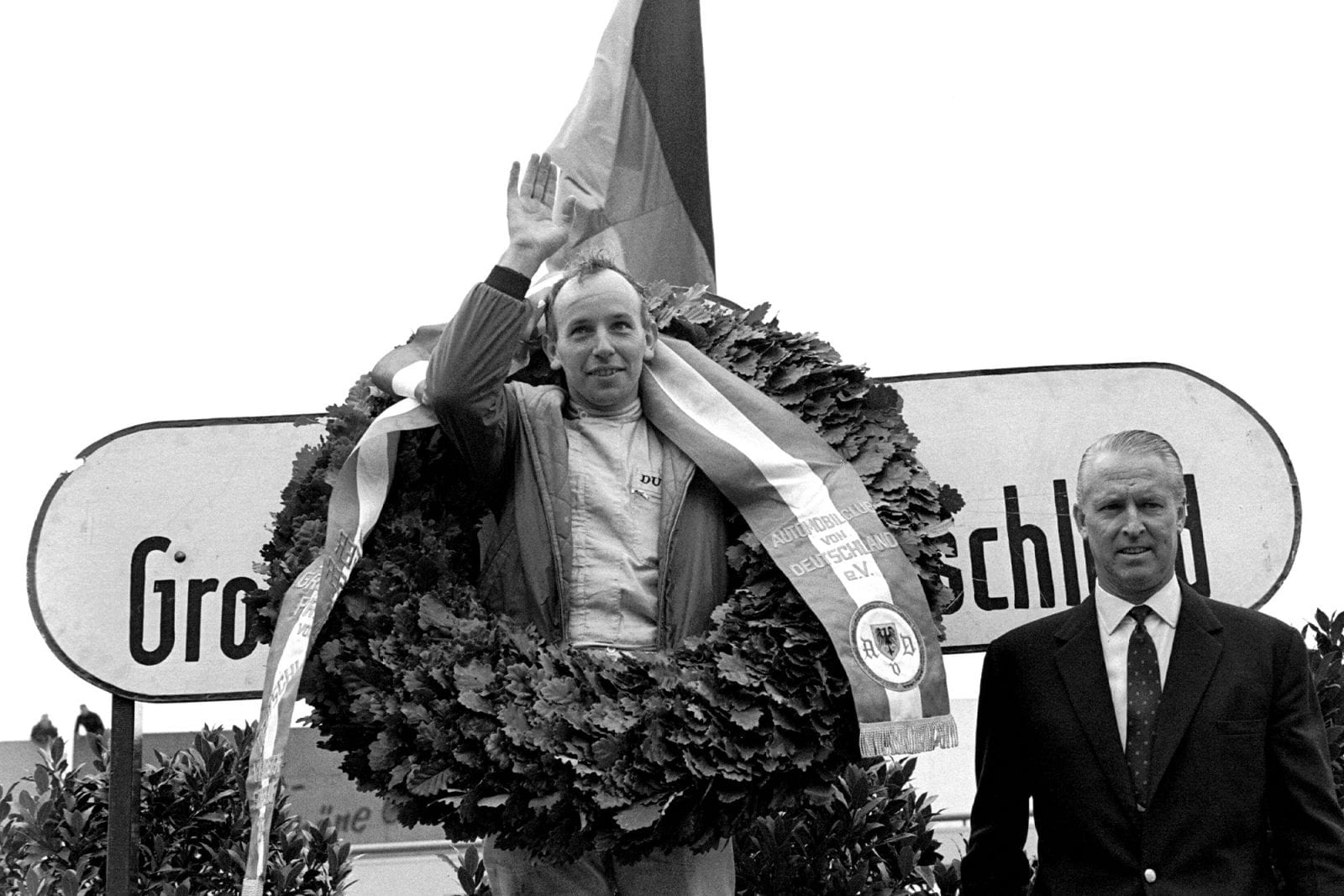
For the second year in a row Surtees took victory at the Nurburgring
Motorsport Images
The German Grand Prix took place on the 22.81 kilometre Nurburgring, in the Eifel mountains and there were four separate practice sessions, two on Friday and two on Saturday, with sufficient time in between each day for fairly major jobs to be undertaken. With the exception of the British Racing Partnership team all the regular Grand Prix teams and private owners were competing plus the long awaited Honda car from Japan.
Team Lotus were still without Arundel, though he is now well on the mend, and Spence was number two to Jim Clark, while a third entry was made for the German driver Gerhard Mitter. Clark had a brand new Lotus 33, outwardly looking like the well-tried Lotus 25, but incorporating all the modifications made during this season to the earlier models. As is normal practice it was using a Coventry-Climax V8-engine, with Lucas fuel injection, a 5-speed ZF gearbox of the latest pattern that has proved remarkably trouble-free this season, Girling disc brakes and 13 inch alloy wheels shod with the wide-tread Dunlop tyres.
Spence had the earlier Type 33 that Clark crashed at Aintree, since rebuilt and used by Clark to win the recent Solitude Grand Prix, while Mitter had the loan of the much modified Type 25 that Clark has been using in most of the races this season until now. The Owen Racing Organisation intended to run three BRM cars, the two 1964 monocoque cars and the 4wd car, but the last car was not ready and the entry was withdrawn, leaving Graham Hill and Ginther with the two earlier 1964 cars, fitted with the latest type of 6-speed gearbox; the newest 1964 car was crashed at Solitude and required a complete rebuild.
Jack Brabham’s Racing Organisation entered the owner himself and Gurney with the two Brabham-Climax cars they have raced all season, Brabham’s own car having had a completely new rear end welded on to the chassis frame after the Solitude debacle. SEFAC of Modena, or the Scuderia Ferrari at we know it, entered Surtees with one of the new V8-engined cars, the other V8 being a spare for him, and Bandini with the earlier V6-engined car.
“Rob Walker put a stop to Bonnier hopping from Brabham car to Cooper car and not really learning to drive either of them”
The Cooper Car Company Ltd, entered their two factory drivers, McLaren and Phil Hill with the two 1964 cars, which are beginning to look a bit second-hand, and the Parnell Racing Team had their two Lotus 25 cars with BRM engines for Hailwood and Amon. The motorcycle ace was feeling a bit secondhand having crashed heavily in the East German Grand Prix on an MZ motorcycle, and he still had a big bump on his head and a nasty cut. Amon’s car had required a pretty extensive rebuild after the Solitude accident, the riveted pontoons of the Lotus chassis requiring straightening and patching with riveted gussets.
Rob Walker put a stop to Bonnier hopping from Brabham car to Cooper car and not really learning to drive either of them, by entering Edgar Barth in the 1963 Cooper-Climax V8 and Bonnier in the 1963 Brabham-BRM V8. The Scuderia Centro-Sud entered Baghetti and Maggs on their two ex-works BRM cars, and the rest of the field was made up by private owners, Anderson (Brabham-Climax V8), Siffert (Brabham-BRM V8), Trintignant (BRM V8), Revson (Lotus-BRM V8), de Beaufort (Porsche 4cyl) and Pilette (Scirocco-Climax V8). To complete the list was the entry from the Honda Motor Co Ltd of Tokyo of the new V12-cylinder car for Bucknum to drive.
Qualifying

Mitter was the extra entry for Lotus
Motorsport Images
Practice began on Friday morning and a number of people were in trouble quite early on, Amon not getting a full lap in due to persistent misfiring which later proved to be ignition trouble. The Honda made an inauspicious start, boiling as soon as it was wound up and most of the morning was spent dismantling and inspecting the water pump, though later it transpired that the radiator was at fault.
Revson spun and cut the nose of his Lotus off on a tree, luckily not doing any more serious damage, and Brabham blew his engine up. Graham Hill went out and did a number of laps on the trot and profited from it by making fastest lap in 8min 44.4sec.
This was not only below the existing lap record of 8min 47.0sec set up by Surtees last year, but also below the 8min 45.8sec set up by Clark in practice last year. Various improvements to the Nurburgring showed earlier in the year that speeds would be higher, but to start the ball rolling with 8min 44sec, was quite something. Surtees was not far behind in the V8 Ferrari with 8min 45.2sec and Gurney went round in 8min 47.8sec, but Clark did not break 9min as he was spending most of the time getting the brand new Lotus sorted out and working properly.
No one else made any startling laps, though all except Mitter, Pilette and de Beaufort were going round. During the interval before the next practice session there was practice for GT cars and for saloon cars, ready for some minor races, and while this was going on the Brabham mechanics did a remarkably quick engine change on the guvnor’s car, and the Parnell mechanics patched up the nose cowling of Revson’s Lotus, while others changed springs, gear ratios, anti-roll bars, tyres-and so on, all ready for another go at the arduous circuit at the end of the afternoon.
Graham Hill did a lot of experimenting with various settings during the afternoon practice period, but finished up with a lap slightly slower than his morning time, but Bandini pressed on to good effect and beat everybody with a time of 8min 42.6secs. Surtees was right behind him with 8min 43.0sec, but was wondering whether the V6-engined car wasn’t more suitable for the Nurburgring; he took the older of the V8 cars out but did not complete a lap before it broke and he had a long walk back! The new Lotus was beginning to go properly and Clark got very near the existing lap record but it was not completely sorted out.
Gurney was showing the true paces of the Brabham and was only fractionally slower than Surtees, and Brabham himself got below the 9-minute mark, which was obviously going to be a good bogey time for all and sundry, while 8min 40sec was in sight for the “big four.” Spence was not going unduly fast, taking time to find his way round the circuit but Amon put in some very fast laps, his best being 8min 54sec, while Siffert was going well. The Honda was still not being very impressive, running on nine cylinders more often than 12 cylinders, and not pulling anything like the “spoken of” 12,000 or 13,000rpm along the straight.
Mitter was still unable to practise, as Colin Chapman was not going to let him borrow the spare Lotus until Clark was certain about the new car, and being over 5 seconds slower than Bandini, it was obvious that Clark was not yet certain about the new car. On paper Bandini seemed to have pulled something out of the bag, beating all the stars, but in reality it was a false impression, for the fast drivers knew where they were going to make up time once their cars were going properly. Even so, Bandini’s time was a splendid effort on his part and he well deserved the moment of glory he had until practice resumed on Saturday morning bright and early.
Until now the weather had been first class, though perhaps a bit too warm for engines to work at full efficiency, but on Saturday morning it was quite cold and there was rain in the air. This was ideal for engine power and Surtees very quickly made use of the good conditions and was the first to get under the 8min 40sec limit, with a time of 8min 39.2sec, a truly shattering effort, for it was not long ago when a 9 minute lap on the Nurburgring seemed impossible.
Clark was concentrating all the time on the new car and got down to 8min 42.2sec, which indicated that things were steadily improving, but Graham Hill was not making much improvement over his first fast time.
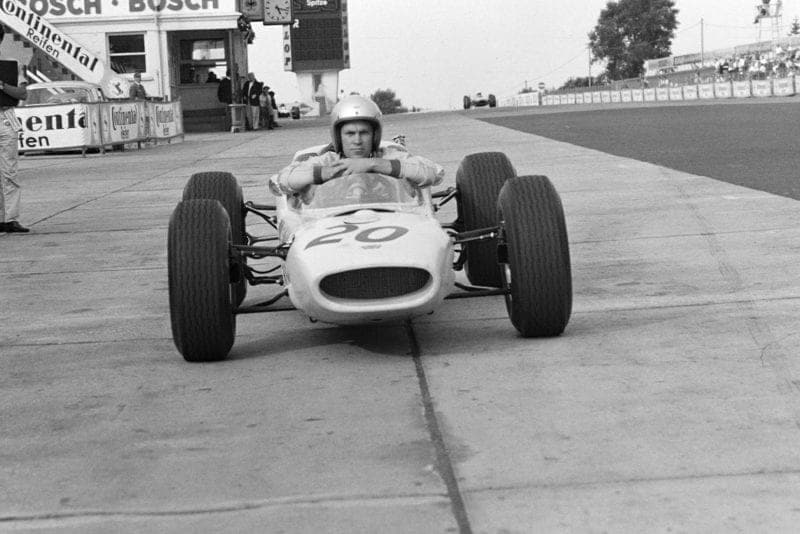
Bucknum was having severe reliability issues in the Honda
Motorsport Images
Not long after these fast laps had been made there was a sprinkling of rain and anyone who had not already had a good go, were out on a slippery track and times were naturally slower. The Honda was still in trouble, being reluctant to start promptly and then seldom running on all 12 cylinders. Before Bucknum had completed a full lap the engine broke and it had to be towed in and work started on fitting another engine/gearbox/final drive unit complete. Ginther also failed to come back after setting off from the pits, for he inadvertently changed into a lower gear instead of a higher one and the BRM engine revved as the Honda is supposed to do, and the valves and pistons became tangled.
The fourth and final practice session took place at lunch time, and the interval was not long enough for the Japanese mechanics to change the Honda engine, nor for the BRM mechanics to install another engine in place of Ginther’s broken one. Although wet to start with, the track soon dried up and there was some pretty incredible pressing-on, led by Surtees. Not content with breaking 8min 40sec in the morning, he went even faster and clocked 8min 38.4sec, and Gurney showed that he was not going to get left behind by recording 8min 39.3sec, but Graham Hill was quite a lot slower, and before he could do anything about it he did what Ginther had done earlier in the morning, with the same disastrous results.
Although he blamed himself for a moment of inattention, it was strange that both cars should suffer from the same complaint, so that it might have been that the chassis was twisting and putting the gearbox selectors out of phase with the cockpit lever, there being no gate for the lever to run in. Whatever it was, it meant that another team of BRM mechanics had to set to work and change an engine. McLaren got well under 9min, as did Siffert, which was a splendid effort for a private owner; but Anderson was less lucky, the right lower radius arm pulling away from the chassis and tearing the mounting away from the welding.
Mitter at last was allowed a few laps in the spare Lotus and with only two flying laps he did 9min 14.1sec, a time that many people had been trying to reach for the past two days! Almost at the end of practice de Beaufort was trying hard with his old Porsche in order to qualify for the starting grid, when he crashed badly at the Bergwerk corner. Although he was rushed to hospital and given immediate attention, his condition was very critical and he died on the following Monday; an unhappy death for the large, amiable Dutchman raced essentially for his own enjoyment and always as a truly sporting amateur driver.
While no one realised the seriousness of his accident there was still some fast lapping going on, and Clark improved even more and very nearly equalled Surtees’ time, with 8min 38.8sec, frankly admitting after that one that he had “made a bog up” of at least three of the corners. The final analysis of the four periods of practice saw a remarkable starting grid with the first three drivers under 8min 40sec, the first six all below the existing lap record, and the first eleven drivers all under nine minutes.
While sorting out the qualifying times the organisers discovered that the Honda had not completed its compulsory minimum of five laps, and neither had Mitter, so there was a bit of an impasse, for while neither entry was going to figure very high up in the results they were both very important prestige figures on the starting grid, the Honda being in its first race and Mitter being a very popular German driver. Embarrassment was diverted by laying on an extra practice session at the end of the afternoon, in which they could both complete their quota of laps, but lap times would not be taken. The Honda was ready with its new engine, sounding much crisper and definitely on 12 cylinders, and Ginther’s car was also completed, so he took the opportunity of bedding it down. Mitter ran the Lotus 25, and Bonnier also went out, in the Walker Brabham-BRM, for a bit more practice, and the long day ended with everyone being satisfied.
Race
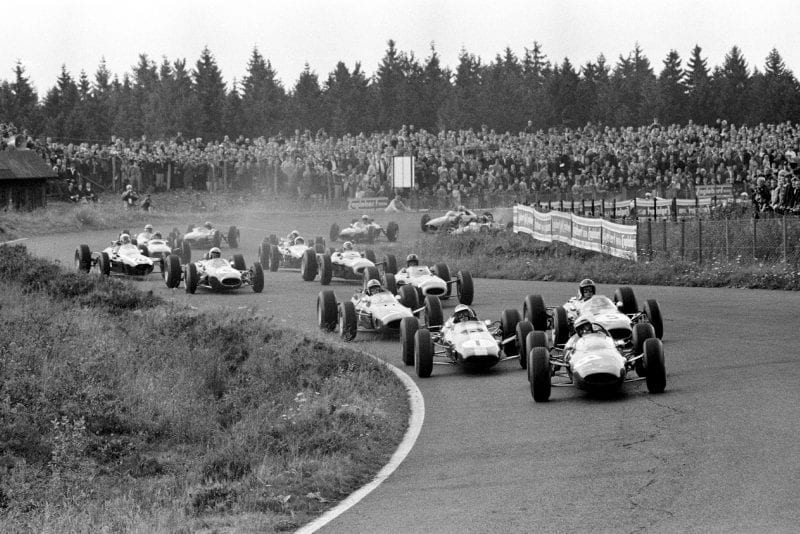
Lorenzo leads the pack through the opening corners
Motorsport Images
Sunday was a comparatively leisurely day, the Grand Prix starting at 2pm, so that everyone had plenty of time for preparation, and the morning was taken up by a 5-lap bicycle race; in which the pedallers rode the circuit in the reverse direction to normal, which meant that they went down from Hohe-Acht and round the Karussel at a fair old lick, and perspired freely up the Fuchsrohre. Weather conditions were just about perfect for high-speed motoring, with cool and cloudy skies and a dry track as the cars lined up on the grid. The recommended “dummy grid” type of start was not used as the starter had not had experience of the procedure, nor had he ever witnessed one, and was not prepared to start experimenting at this stage.
On the wide and spacious starting area of the Nurburgring the “dummy grid” system would not have offered much advantage, and the start was given perfectly, Clark almost jumping the flag and then having to have a second bite, and there was some furious wheelspin from the front row; Surtees just had his nose in front as they went by the pits, but it was Bandini into the lead at the Sudkehre. Along the back of the pits Clark went by and led away on the opening lap.
The Honda had got away slowly from its position at the back of the grid and clearly Bucknum did not intend to get too involved in his first Grand Prix race with the brand new car, treating the whole thing as a test-run. From practice times it looked as though Clark was not going to get rid of Surtees very easily, if at all, and though the Lotus led for the first lap the Ferrari was right on its tail as they came over the brow of the Tiergarten and past the pits; and Gurney was right there with them, followed by Graham Hill, Brabham, Phil Hill, Bandini, McLaren, Ginther and Amon.
As the leading pair braked for the Sudkehre Surtees took the lead, and headed Clark as they set off on lap two. At the back of the field there was all sorts of trouble, for Bonnier had come to rest barely half-way round the opening lap with violent electrical discharges that ruined the battery, and Hailwood had left a trail of oil for a long way round the circuit before coming to rest with a blown-up engine.
Mitter had gone too softly at the start and had wetted some of the sparking plugs, and limped into the pits for a change, as did Revson, while Anderson had had his water-filler cap come undone and lost a lot of water, and came in to top up. The Honda had overtaken Barth, Spence, Trintignant and Baghetti, and was going quite well, sounding healthy for a change.
“Surtees held the lead from Clark, but he could not get away from the Lotus, and Gurney and Graham Hill were still close, so that all four went by the pits in line-ahead formation”
During the second lap Surtees held the lead from Clark, but he could not get away from the Lotus, and Gurney and Graham Hill were still close, so that all four went by the pits in line-ahead formation, with very little between them, but the average speed had dropped considerably due to the oil dropped by Hailwood’s Lotus-BRM. Whereas they had done the standing lap in just over 8min 56sec, the first flyer was 9min 01sec, and until the oil dried up there was no chance of really fast laps.
Baghetti came into the pits and retired his Centro-Sud BRM, and Anderson was back in again to see if he could improve the handling of his car by altering the front anti-roll bar. During the third lap Gurney got by Clark, and it looked as if the Lotus driver was having trouble and, sure enough, he went by the pits in third place making distress signs to his pit. Phil Hill had retired on the second lap when the Climax engine of his Cooper blew up with a big bang, and McLaren went by to start lap four with his engine misfiring badly, so it was not a Cooper day. It was not a BRM day either, for Ginther stopped at the pits to have the plugs looked at as his engine was misfiring as well, but Mitter was now going well after his slow opening lap.
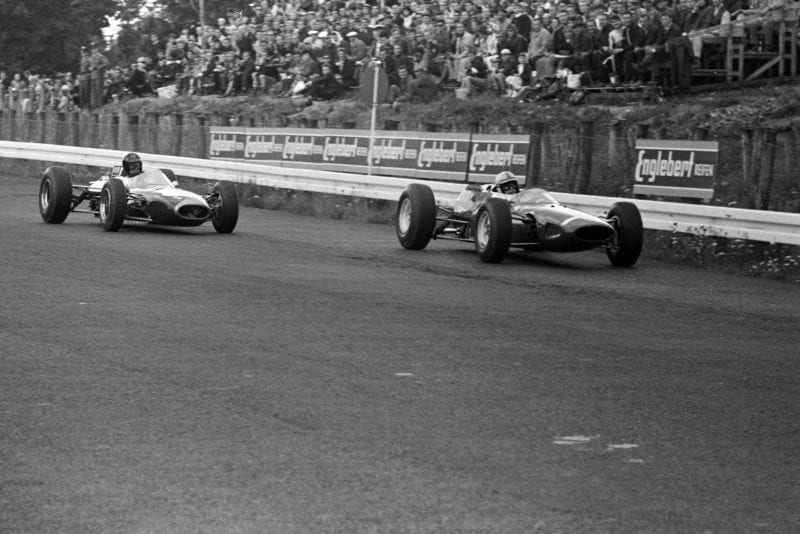
Gurney and Surtees fought for the lead early on
Motorsport Images
As Surtees braked for the North turn to start his fourth lap, Gurney came right up alongside him and was pushing hard down through the woods. Eventually Surtees ran a little wide on one corner and Gurney was through on the inside and into the lead, but the Ferrari was right with him all the way and they finished lap four with only a few feet between them, and it was seen that the Brabham car had collected some paper in its radiator opening.
“As Surtees braked for the North turn to start his fourth lap, Gurney came right up alongside him and was pushing hard down through the woods”
Graham Hill was now in hunt of Clark and they had both fallen back from the leaders, for the oil was drying and the pace was quickening. In fifth place Brabham was running strongly, leading Bandini, but McLaren came into the pits to retire, his Climax engine making clicking noises in the valve gear that were not intentional. This let Amon up into seventh place and Siffert eighth. Barth disappeared out on the circuit when the Cooper clutch packed up, and Anderson made yet another visit to the pits.
Surtees had the lead back on lap five but Gurney was alongside again as they started lap six and got the lead, only to lose it again by the time they were half-way round the lap, but there was still nothing between them and neither driver was giving way or making it easy for the other, so that the crowd of over 300,000 spread all round the course were seeing some truly magnificent Grand Prix racing, no matter where they were watching.
At the end of lap six they were still together and were jointly credited with the fastest lap, in 8min 47.5sec, and had left Graham Hill and Clark some way back, while the rest of the runners were spread all round the circuit by now, the tail-enders about to be lapped. Ginther’s BRM was still misfiring badly and it was behind the Honda, which was running pretty regularly.
Gurney’s Brabham-Climax was now showing signs of trouble, for the pressure in the water system was going up and the temperature was rising, which rather indicated an internal compression leak into the water system, though onlookers wondered if it was the paper blanking off the radiator that was causing the overheating.
However, had this been the case the water-pressure gauge would not have indicated a rise, only the temperature, and by easing off slightly the pressure dropped. While watching this, Gurney was forced to drop back a bit and Surtees made full use of his very healthy Ferrari and set a new lap record in 8min 45.1sec on his seventh lap. Graham Hill was still in third place, but unable to challenge the leaders, and Clark was long overdue, eventually appearing over the Tiergarten and heading straight for the pits. There was something wrong with the left-hand bank of cylinders of the Climax engine, and number three plug was removed and found to have been badly hammered by something inside the cylinder!
It was screwed back in and the car was wheeled away, for an exhaust valve had stuck open and obviously become very bent by being hit by the piston and the inlet valve, and the inlet camshaft had sheared its driving pin. Clark explained that his troubles in the opening lap had been caused by the gearbox changing from 2nd to 5th gear, instead of 3rd gear, so that he kept having to make a second go at changing-up, which sounded rather like the BRM trouble of chassis flexion over the Nurburgring undulations.
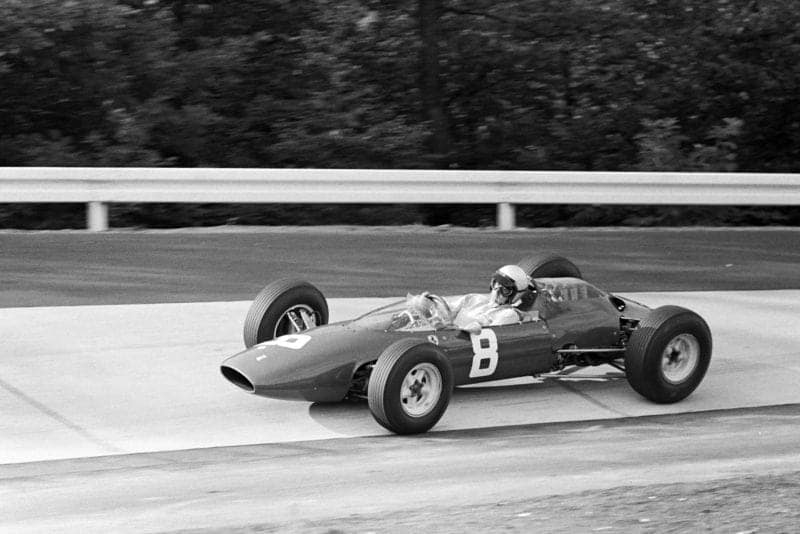
Bandini secured 3rd place for Ferrari
Motorsport Images
The race was over 15 laps of the circuit and while on the eighth lap, or half distance, the order was Surtees well out on his own in a very healthy sounding V8 Ferrari, Gurney in second place with overheating troubles, Graham Hill in third place with an engine that was beginning to misfire, and a long way behind came Brabham, followed by Bandini, and then another long gap and Siffert and Amon, while an even longer gap separated them from the remainder, who came by in the order Maggs (BRM), Trintignant (BRM), Spence (Lotus-Climax), Bucknum (Honda), Ginther’s misfiring BRM, Mitter (Lotus-Climax) going well, but a long way back after his first lap stop, and Revson already lapped by Surtees.
Lap eight saw Surtees set up another lap record, in 8min 43.0sec, and by the end of lap nine he had pulled out 16sec on Gurney, who was slowing up trying to control his overheating problem, and he went by the pits making “water” signs to his pit. Brabham was firmly in fourth place, unable to catch the third-place man, so he began to relax and think about other things, and Bandini closed up on him.
When Brabham looked in his mirror and saw a red Ferrari behind him he thought it was Surtees about to lap him, and moved over and waved it by; he got a big shock when he saw it was Bandini who went by. It took Brabham a whole lap to get back in front again, for Bandini was not dozing, and he actually held fourth place for two laps on the scoreboard. Having decided that his water problem was not going to be solved, Gurney set about catching up Surtees and set up a new lap record in 8min 42.9sec on lap 10, to which Surtees replied with a shattering 8min 39.0sec on lap 11.
Gurney’s overheating now got really bad and he slowed right up and let Graham Hill by into second place, and at the end of lap 11 he came into the pits. Although hot, the water was not boiling and the system was full, so there was little that could be done and Gurney went back into the race, but he was now well back and he did only one lap before returning once more, this time the water level being low.
On this lap Brabham had come to rest with a broken crown-wheel and pinion, having been well ahead of Bandini at the time, and at the end of the lap Amon stopped at the pits as his car seemed to be handling in a peculiar fashion. With all the troubles of the others, he was in fifth place, but he did not enjoy it for the strange handling was found to be due to the right-hand top rear radius-arm mounting having pulled right away from the chassis. The Honda also failed to appear on this lap, and it was reported that Bucknum had spun off before the Karussel and wrecked the car, but got away uninjured.
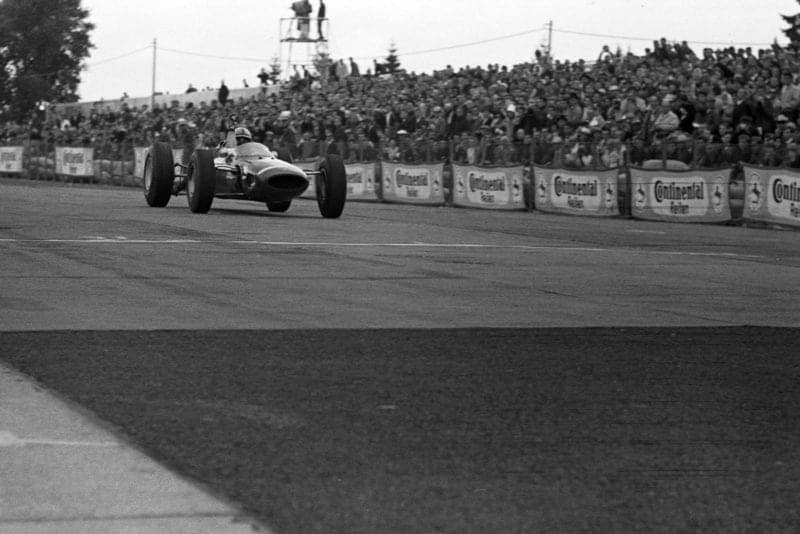
Surtees is jubilant upon taking a second Nurburgring victory
Motorsport Images
The situation was now Surtees the complete master of the race and the Nurburgring, followed a long way back by Hill in an ailing BRM that he was nursing along, mostly in top gear, and then even further back came Bandini and Siffert, while Trintignant and Maggs were very close together, racing for sixth place but nearly a lap behind the leader, the remaining four runners being lapped. On his penultimate lap Surtees lapped Maggs, but did not quite catch Trintignant, so that as the chequered flag was prepared to greet Surtees on completion of his 15th lap Trintignant went by to do one more lap.
“The situation was now Surtees the complete master of the race and the Nurburgring”
A jubilant Surtees completed the 15 laps, the Ferrari sounding as healthy as ever, and a happy Ferrari team greeted him. A worried Graham Hill got his misfiring BRM home into second place and Bandini scored a worthy third Ogee, while an astounded but very pleased Siffert finished fourth. While the winner was being acclaimed Trintignant was still completing his final Iap and would have been in fifth place on the same lap as the leader, but the BRM broke down on the final straight, and though the little Frenchman pushed the car home he could only be credited with 14 laps.
Before the race there was so little difference between Surtees, Clark and Gurney, in Ferrari, Lotus and Brabham, respectively, that the only possible outcome of the race seemed to be one of the strongest and most reliable car, and that was just how it turned out, the Ferrari proving fast, strong and reliable while Coventry-Climax and BRM engines faltered and fell.
